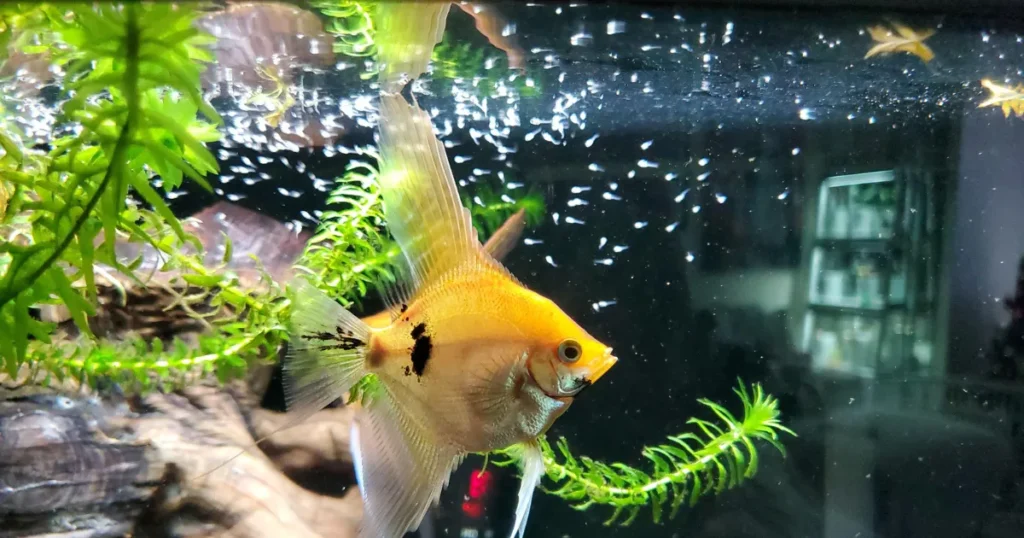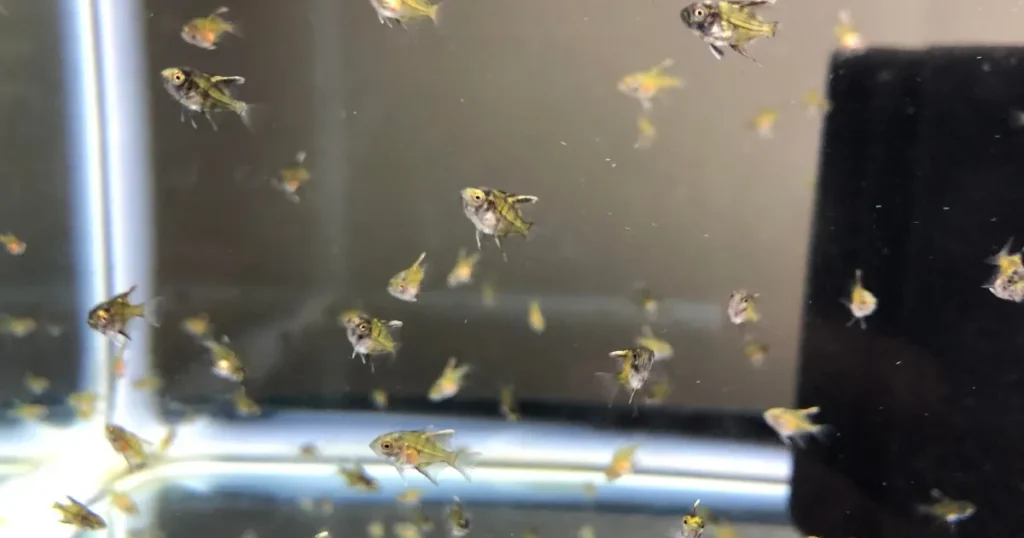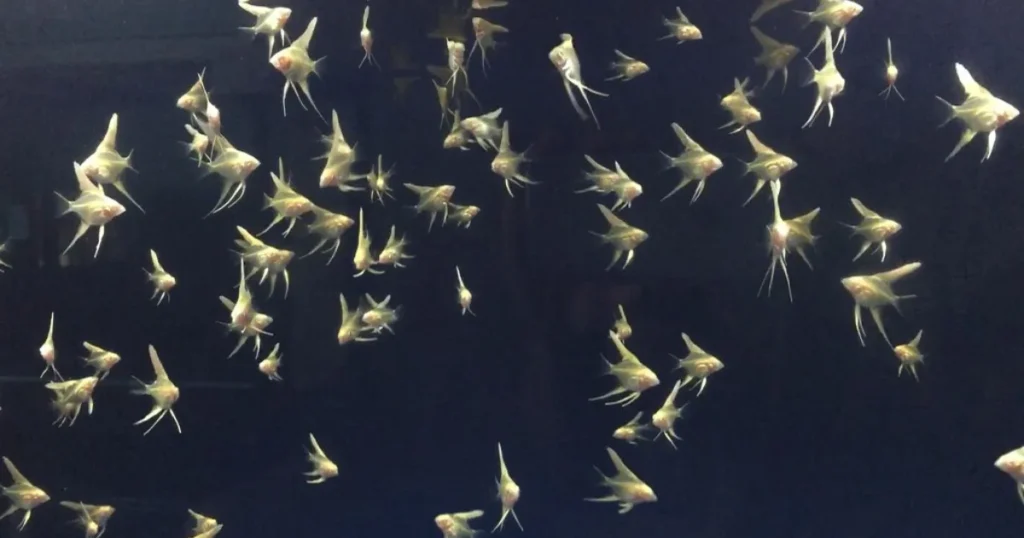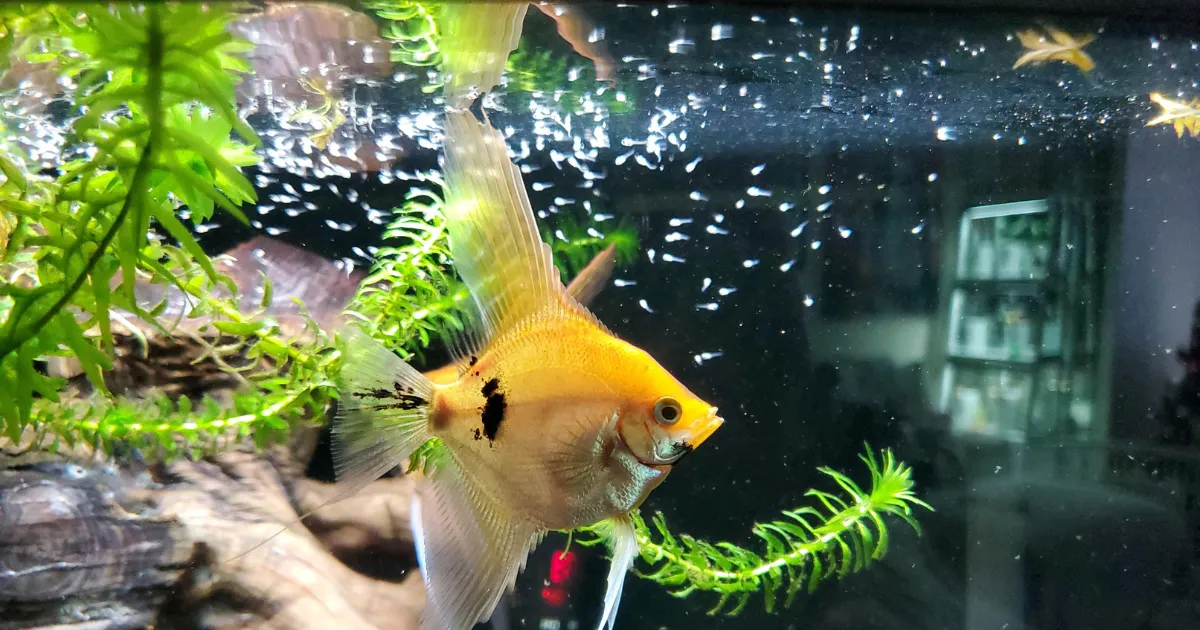Raising healthy angelfish fry can be an exciting and rewarding experience for any aquarium hobbyist. However, it also requires dedication and attention to ensure the fry grow and thrive. This beginner’s guide covers everything you need to know about angelfish fry care at different stages, including feeding tips, tank setup, water quality, and tips for healthy growth.
Introduction to Angelfish Fry Care.
Fry of angelfish require specialized care, especially in the initial few weeks when they are extremely delicate and vulnerable. With the right environment and feeding, they can grow over 2-3 times their initial size in the first month itself!

Understanding the different developmental stages of the fry and tailoring care accordingly is key to raising a healthy brood. Proper nutrition, clean water, and a safe tank setup will give them the best chance at survival and growth.
While fry care can seem daunting for beginners, following some basic guidelines on feeding, tank maintenance, and managing water parameters will set you up for success.
Understanding the Different Angelfish Fry Stages Development.
Angelfish fry undergo tremendous growth and development within the first 2 months. By understanding the different stages, you can provide stage-specific care.
1. Egg Stage
The egg stage lasts for 2-3 days after spawning. The parents will usually care for the eggs during this period. Remove any fungused eggs promptly.
Angelfish lay eggs on flat surfaces like leaves, rocks, or driftwood. It’s optimal to move the eggs to a separate rearing tank before hatching.
2. Newly Hatched Fry
Newly hatched angelfish fry will be tiny, around 2-3 mm long. They cling to surfaces with their egg sac still attached for nourishment.
Keep the rearing tank bare with smooth surfaces for the fry to attach to. Have the tank fully cycled before introducing the fry.

3. Free-Swimming Fry
Within 5-7 days from hatching, the fry will detach and start swimming freely. They will deplete their egg sac by 2 weeks.
Now you must start feeding the 2 week old angelfish fry small feeds several times a day. Micro worms, infusoria, egg yolk are ideal starter foods.
4. Juvenile Stage
At 3-4 weeks, the juvenile fry will be around 6-8 mm long. Increase feed amounts gradually. Introduce crushed flakes, small live/frozen foods like brine shrimp.
Frequent water changes and tank maintenance becomes crucial as bioload increases. Watch for aggression as juvenile angelfish establish hierarchies.
5. Subadult Stage
Around 6-8 weeks, the subadult angelfish reach 12-15 mm in size. They will start developing adult coloration.
Continue varied, protein-rich feeds. Check water parameters daily. Separate bullies or faster growers to prevent stunted growth.
Read More About Angelfish Egg.
What to Feed Angelfish Fry at Different Stages.
The dietary needs of angelfish fry change as they develop:
Newly Hatched Fry
- Infusoria: Single-celled microorganisms provide nourishment to fry younger than 5 days old.
- Egg Yolk: Hard boiled egg yolk finely crushed and mixed into tank water for 1st week fry.
- Powdered Fry Food: Commercial powdered fry starter foods provide protein and nutrients.
2 Week Old Fry
- Micro worms: Keep a micro worm culture ready to feed fry once free-swimming. Rinse well before feeding.
- Brine Shrimp: Newly hatched brine shrimp nauplii are excellent starter live food after 1 week.
- Crushed Flakes: Soak high protein flakes in vitamin supplement and feed crushed fine.
Juvenile & Subadult Fry
- Live/Frozen Foods: Bloodworms, daphnia, cyclops are great for protein and growth.
- Prepared Fry Foods: Specially formulated powder/granule mixes provide balanced nutrition.
- Flakes & Pellets: Introduce 200-400 micron sized flakes. Soak 1mm pellets before feeding.
Feeding Tips for Angelfish Fry.
Feeding angelfish fry appropriately is essential for quick growth and health. Follow these tips:
- Start Feeding Early: Begin feeding newly hatched fry infusoria. Once free-swimming, feed small amounts 5-6 times daily.
- Offer Live Foods: Live foods like micro worms, brine shrimp provide nutrients and induce foraging behaviors.
- Pre-Soak Dry Foods: Soak flakes and pellets in tank water for 1-2 minutes before feeding to soften them.
- Variety is Key: Rotate through different protein sources for balanced nutrition.
- Crush Foods Initially: Use a mortar and pestle to crush foods to a fine powder for fry under 2 weeks.
- Feed Little And Often: Feed very small amounts multiple times per day. Young fry have tiny stomachs.
- Target Feed: Use a pipette or dropper to target feed fry directly. This ensures all fry get nutrition.
- Check for Leftovers: Clear any uneaten food after 1-2 hours to avoid fouling the water.
- Adjust as They Grow: Slowly increase size of feeds as the fry grow over 8 weeks.
How to Feed Angelfish Fry Effectively.
Follow these methods to feed angelfish fry successfully:
- Use a Small Container: Collect fry in a small tank/container during feeding. This concentrates them and ensures they all find food.
- Target Feed: Use an eyedropper or pipette to drop food right near each fry. This makes feeding more efficient.
- Feed in Small Portions: Put in only as much food as the fry can consume in 2-3 minutes. Remove leftovers promptly.
- Spread it Out: Distribute feed around tank to prevent competition. Use feeding rings to contain food in one area.
- Feed More Often: Young fry need to be fed 4-6 small meals daily rather than 1-2 large feeds.
- Soak Dry Foods: Micropellets and powdered feeds should be soaked in tank water for 1-2 minutes before feeding fry.
- Do Not Overfeed: Watch for signs of overfeeding like lethargy or leftovers accumulating on tank bottom.
- Rinse Live Foods: Rinse live foods like brine shrimp in treated water before feeding to remove debris/pathogens.
How To Take care Of Angelfish Fry?

The Importance of Water Quality for Angelfish Fry.
Maintaining excellent water quality is crucial when rearing angelfish fry. Here’s why:
- Fry Are Vulnerable: Poor water quality can be rapidly fatal to fry. Ammonia and nitrite are highly toxic.
- Fry Add Bioload: The increasing bioload as fry grow makes frequent water changes essential.
- Promote Healing: Pristine water will allow injured or bullied fry to heal quicker.
- Prevent Disease: Good water quality prevents fungal, bacterial and parasitic diseases.
- Ensure Growth: The faster the fry grow, the bigger their appetite and bioload. Keep water clean.
- Reduce Stress: Water changes lower stress hormones that could suppress the fry’s growth.
- Encourage Foraging: Fry feed more eagerly in clean, well-oxygenated water.
Read More: Best Aquarium Canister Filter…
Providing the Right Environment for Angelfish Fry.
Rearing angelfish fry successfully requires setting up an optimal tank environment. Here are some key points:
- Pre-Cycle the Tank: The fry tank must be fully nitrogen cycled before adding fry.
- Use a Sponge Filter: A soft sponge filter prevents fry from getting sucked in or injured.
- Control Ammonia: Have ready supplies of ammonia remover like Seachem Prime and live plants.
- Provide Cover: Include floating plants, plastic wrap over part of the tank as hiding spots.
- Use a Heater: Maintain a stable temp of 82°F. Chillers might be needed in hot climates.
- Subdued Lighting: Bright light stresses young fry. Use a dimmer or floating plants to filter light.
- No Tank Mates Initially: Avoid placing tank mates that could prey on or outcompete fry.
- No Gravel or Decor Initially: Bare bottom tanks make maintenance easier with heavy fry bioload.
- Daily Maintenance: Test water parameters and siphon waste daily. Do 25% water changes every 2-3 days.
How to Care for 2 Week Old Angelfish Fry.
The 2-week mark is a pivotal stage in angelfish fry care. Here are some guidelines:
- Start feeding the free-swimming fry 5-6 small meals daily. Schedule feeds evenly over the day during daylight hours.
- Microworms and newly hatched brine shrimp are ideal starter live foods. Rinse well before feeding.
- Alternate live foods with soaked powdered fry foods or crushed high-quality flakes with added supplements.
- Use a plastic pipette or dropper to target feed fry directly. Draw in and release food right in front of a fry to ensure it eats.
- Put in food in tiny portions over 15-20 minutes. Any leftovers must be siphoned out after 1-2 hours to prevent fouling. Avoid overfeeding.
- Test water parameters daily. Ammonia and nitrite should be undetectable at this stage. Do 25% water changes every other day.
- The fry will still be fragile at 2 weeks old. Provide ample hiding spots with floating plants and tank covers. Keep lighting low.
- Check for signs of disease and remove any deceased fry promptly. Fungal infections are common at this age.
- The fry will be developing adult characteristics and starting to shoal. Watch for bullying behaviors and separate aggressive fry.
Common Challenges in Angelfish Fry Care.
Rearing angelfish fry has some common pitfalls to be aware of:
- Fungal Infections: Newly hatched fry are prone to fungus. Maintain excellent hygiene and water quality. Use antifungal treatments if needed.
- Lack of First Foods: Having infusoria ready or delaying separation from parents prevents newborns from starving.
- Cannibalism: Older fry may attack and eat younger, smaller tankmates. Remove aggressors promptly.
- Poor Water Quality: Fry are extremely sensitive to toxins. Lapses in tank maintenance can wipe out a whole brood rapidly.
- Intestinal Blockages: Overfeeding dry foods can cause fry to bloat and develop blockages. Soak dry foods well.
- Bullying & Stunting: Aggressive fry suppressing tankmates is common. Separate by size to ensure even growth.
- Inbreeding Depression: Breeding related fish can lead to deformed, sickly fry. Introduce new breeding stock periodically.
- Moving Fry Prematurely: Newly hatched fry moved too early often fail to thrive and perish. Leave with parents for 5-7 days minimum.
Tips for Healthy Growth of Angelfish Fry.
Promoting fast yet healthy growth requires focus on these aspects:
- Vary Their Diet: Rotate through different protein sources like bloodworms, brine shrimp, daphnia, and high-quality prepared fry foods.
- Introduce New Foods Gradually: When introducing unfamiliar foods, mix with previous foods in increasing ratios over 4-5 days.
- Provide Supplemental Feeding: Use vitamins like VitaChem or Selcon to coat live and frozen foods. This corrects nutritional gaps.
- Cull Weak/Defective Fry: Selectively removing weaker, deformed fry helps channel resources to the healthy fry.
- Isolate Bullies: Aggressive tankmates stunt others’ growth. Remove bullies or faster-growing fry to separate tanks.
- Do Daily Maintenance: Test water parameters and siphon waste from the tank bottom daily. Fry have high bioloads.
- Reduce Water Movement: Fry prefer still water. Position outflow to create a gentle current of 1-2 times tank volume per hour.
- Keep Records: Maintain a daily log of feeding schedules, growth rates, tank parameters. This helps refine care.
- Optimize Tank Conditions: Keep temperature stable at 82°F, pH 6-7, and water very soft at 1-4 KH. This stimulates maximal growth.
Steps to Raise Angelfish Fry Successfully.
Follow this checklist to raise a healthy brood:
- Set up a dedicated, fully cycled 10-20 gallon rearing tank before spawning. Use an air-powered sponge filter and heater.
- As eggs near hatching, siphon them into the rearing tank carefully. Acclimate by floating the bag.
- Have initial live foods like infusoria and micro worms ready. Once free-swimming, feed small amounts frequently.
- Maintain stable, optimal temperature and water parameters. Change 25% water every 1-2 days.
- Remove any deceased, diseased or deformed fry promptly. Culling helps allocate resources effectively.
- As they grow, transition feeds from live to soaked dried foods. Offer a varied, protein-rich diet.
- Monitor growth and development daily. Separate size groups once disparities emerge to prevent stunting.
- Provide optimal conditions without disturbances or stressors. Use floating plants for infrequent direct feeding.
- Once they reach juvenile stage after a month, can introduce tank decor and switch to a hang-on-back power filter.
- After 2 months as subadults, the angelfish can be combined into a community tank or sold/rehomed.
Final Words: Ensuring the Best Angelfish Fry Care.
While raising angelfish fry is demanding, the reward of seeing a healthy brood transform is unparalleled! The key is tailoring their care to each developmental stage. Meeting their nutritional needs while diligently maintaining water quality gives them a strong start. With attentive, consistent care in their vulnerable early weeks, a brood of angelfish fry can thrive into juveniles ready to become stunning additions to any freshwater aquarium.
FAQs.
How long until angelfish fry start swimming?
Angelfish fry will become free swimming around 5-7 days after hatching. Before this, they absorb nutrients from their yolk sac and remain attached to surfaces.
What is the best food to feed newborn angelfish fry?
Infusoria and microworms are ideal first foods for newly hatched fry. Once free-swimming, they can also be fed newly hatched brine shrimp nauplii and egg yolk.
When can you start feeding angelfish fry flakes?
Flakes can be gradually introduced once the fry are 2-3 weeks old. The flakes should be crushed finely and soaked well before feeding to soften them for the fry.
How often should you feed angelfish fry?
Young angelfish fry need to be fed small amounts frequently, around 4-6 times per day. The feeding frequency can be reduced as they grow.
What causes angelfish fry to die?
Common reasons for fry deaths include fungal infections, starvation, poor water quality, aggression from tankmates, and developmental issues from inbreeding.
How do you know if angelfish fry are getting enough to eat?
Signs that angelfish fry are feeding well include active foraging, visible full bellies, and steady growth in size. Leftover food accumulating indicates overfeeding.
When can angelfish go in a community tank?
Angelfish fry can be added to a community tank once they reach juvenile size of 0.5-1 inch in length, typically around 4-6 weeks old.
How long does it take for angelfish eggs to hatch?
Angelfish eggs typically hatch in 2-3 days. The fry remain attached to surfaces for a few more days before becoming free swimming.
What temperature is best for raising angelfish fry?
Ideally, maintain the water temperature around 82°F while raising angelfish fry. This stimulates fast growth and healthy development.
Do angelfish eat their fry?
Yes, angelfish parents may sometimes eat their own fry, especially if they feel threatened or lack adequate hiding spaces. It’s best to remove angelfish eggs and hatch them separately to prevent this.
How fast do angelfish fry grow?
With proper care and feeding, angelfish fry exhibit extremely rapid growth in their first 2 months. They can reach up to 2-3 times their starting size within the first 4 weeks. Growth rates of 0.5-1mm per day are common in healthy angelfish fry.


